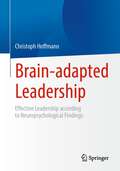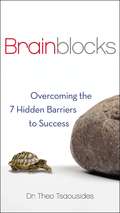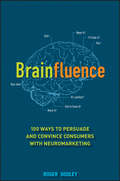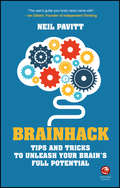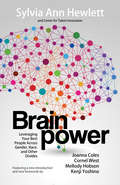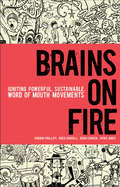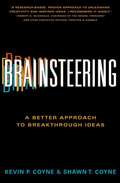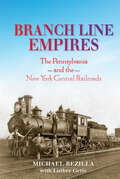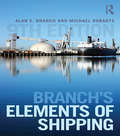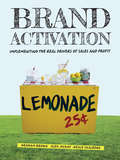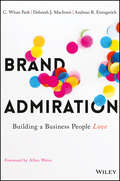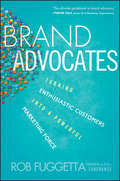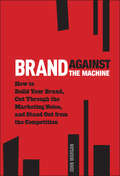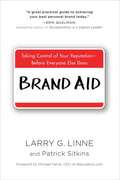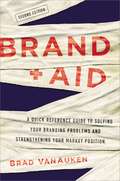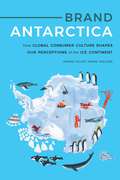- Table View
- List View
Brain-adapted Leadership: Effective Leadership according to Neuropsychological Findings
by Christoph HoffmannThe book shows you how you can effectively integrate the latest findings of neuroscience into your everyday work or leadership. Brain-adapted leadership shows you how applied psychology from the perspective of neuroscience works both in leadership work and in everyday professional life as a whole. Based on a neuropsychological behavioral model, you will learn about the plausible connections between perceptions, needs, emotions, thinking and acting. These insights form a valuable basis for leading yourself, teams and corporate units. In addition, you will receive numerous exercise instructions and examples for illustration and practical implementation. The subject of this work is of particular importance to you if you want to better understand your own feelings and behavior and those of your fellow human beings in order to achieve valuable interactions and fulfilling work activities. Target Audience:This reference book is aimed at managers and coaches, as well as people in the world of work who are willing to work on themselves to achieve greater satisfaction, serenity and balance: and neuroscience knows that we can do this, even into old age. About the author: Christoph Hoffmann is a graduate psychologist FH, graduate engineer HTL; studied psychology with a focus on Industrial and Organizational Psychology in Zurich. He has leadership experience in various adult education institutions and works at the IAP at the ZHAW Zurich University of Applied Sciences as a consultant and lecturer in the Centre for Leadership, Coaching and Change Management.
Brainard, Bennis & Farrell (A)
by John J. Gabarro Andrew BurtisA law firm must decide how to split partnership profits among the partners. Issues of seniority versus performance, performance evaluation, and lack of consensus of values dominate the discussions. A rewritten version of an earlier case.
Brainblocks
by Theo TsaousidesBrainblocks are the mental obstacles that keep people from achieving success, defined as setting, pursuing, and achieving a goal. Managing the brain is the solution to preventing mental blocks from interfering with achieving your goals. And neuropsychologist Dr. Theo Tsaousides gives you the tools to improve: Awareness: * the seven brainblocks to success (self-doubt, procrastination, impatience, multitasking, rigidity, perfectionism, negativity) * the characteristic feelings, thoughts, and actions associated with each brainblock * the brain functions involved in goal-oriented action * brain glitches and how they create setbacks * the cost of not removing brainblocks * the best strategies to remove the blocks Engagement: * actively search for brainblocks in your actions, thoughts, and feelings * recognize and label each brainblock as soon as it is identified * practice each strategy consistently until it becomes second nature * track your progress toward a goal Through these strategies you will learn to overcome these cognitive obstacles and harness the power of the brain to achieve success in any endeavor.
Brainfluence
by Roger DooleyPractical techniques for applying neuroscience and behavior research to attract new customersBrainfluence explains how to practically apply neuroscience and behavior research to better market to consumers by understanding their decision patterns. This application, called neuromarketing, studies the way the brain responds to various cognitive and sensory marketing stimuli. Analysts use this to measure a consumer's preference, what a customer reacts to, and why consumers make certain decisions. With quick and easy takeaways offered in 60 short chapters, this book contains key strategies for targeting consumers through in-person sales, online and print ads, and other marketing mediums.This scientific approach to marketing has helped many well-known brands and companies determine how to best market their products to different demographics and consumer groups. Brainfluence offers short, easy-to-digest ideas that can be accessed in any order.Discover ways for brands and products to form emotional bonds with customersIncludes ideas for small businesses and non-profitsRoger Dooley is the creator and publisher of Neuromarketing, the most popular blog on using brain and behavior research in marketing, advertising, and salesBrainfluence delivers the latest insights and research, giving you an edge in your marketing, advertising, and sales efforts.
Brainhack
by PavittHack into the secret power of your brain Your Brain100 Billion Neurons100 Trillion ConnectionsAnd you only command 5% of it. Now it's time to take back control! In Brainhack, creativity coach Neil Pavitt gives you tips and tricks to re-programme your brain, developing the skills and insights that can transform how you think, solve problems and make decisions. This book will help you: * Learn to think smarter* Become more focused* Discover creative approaches to problem-solving* Generate ideas with innovative techniques* Unlock your brain blocks
Brainlab: Imaging a MedTech Future
by Regina E. Herzlinger Federica Gabrieli Gregory P. LicholaiCan Brainlab, a privately held firm, compete with giants like Medtronic and Amazon in delivering the Digital Operating Room of the future? The CEO is pondering solutions for secure exchange of medical information, pricing a new robotic imaging device, and reorganizing the firm. Thirty years have passed since the self-taught computer programmer Stefan Vilsmeier founded the firm and achieved dominance in many fields. How can he maintain it in the face of this new, powerful, and well-funded competition?
Brainpower
by Cornel West Sylvia Ann Hewlett Kenji Yoshino Mellody Hobson Joanna ColesIs it more profitable for workers and their employers to be "out" in the workplace? What's holding back the "model minority"? A compendium of groundbreaking research studies conducted by bestselling author and notable economist Sylvia Ann Hewlett and her team at The Center for Talent Innovation, Brainpower provides hard data to back up claims, including: The Power of "OUT", Off-Ramps and On-Ramps Revisited, Asians in America, and The X Factor.
Brains on Fire
by Geno Church Greg Cordell Robbin Phillips Spike JonesDevelop and harness a powerful, sustainable word-of-mouth movementHow did the 360-year-old scissor company, Fiskars, double its profit in key markets just by realizing its customers had already formed a community of avid scrapbookers? How is Best Buy planning to dominate the musical instruments market? By understanding the Brains on Fire model of tapping movements and stepping away from the old-school marketing "campaign" mentality.Brains on Fire offers original, practical and actionable steps for creating a word-of-mouth movement for corporations, products, services, and organizations. It takes you step-by-step through the necessary actions needed to start your own authentic movement.Develop and harness a powerful, sustainable, word-of-mouth movementDescribes 10 lessons to master and create a powerful, sustainable movementThe Brains on Fire blog is often ranked in the top 100 of AdAge's Power 150 Marketing Blogs
Brainsteering: A Better Approach to Breakthrough Ideas
by Shawn T. Coyne Kevin P. Coyne“A research-based, proven approach to unleashing creativity and inspired ideas. I recommend it highly.” —Robert A. McDonald, retired Chairman, President, and CEO, Proctor & GambleFrom business strategists (and brothers) Shawn and Kevin Coyne comes a breakthrough approach to developing better ideas. Brainsteering is a comprehensive, research-based, tried-and-tested approach to the principal challenge in business and life: how to consistently and effectively create powerful new ideas. Brainsteering offers a way out of fruitless brainstorming sessions. In the tradition of the Heath Brothers’ Made to Stick and Gordon Mackenzie’s Orbiting Giant Hairball, the Coynes deliver the surest path to success for anyone looking to unlock the secrets of innovation.“Their logical thinking exercises will help readers to maximize their ideation skills, both by systematically exploring every possible nook and cranny of an issue to find new ideas, and by systematically evaluating and honing the results.” —Publishers Weekly
Brainteaser für Anfänger und Fortgeschrittene: 220 Aufgaben mit Lösungen für Gehirnjogging und Logik-Skills
by Yevgen LantsuzovskyyWer seine Konzentration und Auffassungsgabe verbessern will, liegt mit diesem Buch genau richtig. Die vielen praktischen und interaktiven Aufgaben helfen dabei, die Problemlösekompetenz gezielt zu trainieren. Das Buch richtet sich an alle, die Spaß am Lösen herausfordernder Aufgaben haben oder sich auf ein Auswahlgespräch in einem Job-Bewerbungsverfahren vorbereiten möchten. Zu Beginn des Buches finden Sie zehn Brainteaser zum Aufwärmen. Danach werden die theoretischen Grundlagen vermittelt, gefolgt von zahlreichen praktischen Aufgaben aus verschiedenen Brainteaser-Kategorien mit unterschiedlichen Schwierigkeitsgraden. Am Ende können die Leserinnen und Leser ihr gesammeltes Wissen in drei Beispieltests à zehn Aufgaben auf die Probe stellen. Zu jedem Brainteaser gibt es ausführliche und nachvollziehbare Lösungshinweise. Für die zweite Auflage wurde der Inhalt überarbeitet und erweitert. Einzelne Übungsaufgaben sind auch in der Springer Nature Flashcards App abrufbar.Der InhaltLösungsstrategien für BrainteaserMathematisch-analytische AufgabenFang-, Schätz- und Dilemma-FragenDetektiv-Rätsel und grafische ChallengesLösung zu jeder Aufgabe und jedem Probetest
Braintrust: The Blockchain-Powered Talent Network
by Christopher Stanton Joseph B. Fuller George GonzalezSan Francisco startup Braintrust developed a talent network governed and incentivized by a blockchain token as a way to align incentives between clients and freelancers. The COVID-19 pandemic led to a rise of remote work and accelerated the growth of the platform; however, the founders must decide how to sustainably scale the network. They must also make key decisions around global expansion, feature adoption, and recruiting users on both sides of the platform--all while managing the logistics of a decentralized blockchain token.
Branch Line Empires: The Pennsylvania and the New York Central Railroads (Railroads Past and Present)
by Michael Bezilla Luther GetteThe saga of a fierce business rivalry: “Absorbing, well-written . . . will appeal to American history scholars and railroad enthusiasts.” —ChoiceThe Pennsylvania and the New York Central railroads helped to develop central Pennsylvania as the largest source of bituminous coal for the nation. By the late nineteenth century, the two lines were among America’s largest businesses and would soon become legendary archrivals.The PRR first arrived in the 1860s. Within a few years, it was sourcing as much as four million tons of coal annually from Centre County and the Moshannon Valley and would continue do so for a quarter-century. The New York Central, through its Beech Creek Railroad affiliate, invaded the region in the 1880s, first seeking a dependable, long-term source of coal to fuel its locomotives but soon aggressively attempting to break its rival’s lock on transporting the area’s immense wealth of mineral and forest products.Beginning around 1900, the two companies transitioned from an era of growth and competition to a time when each tacitly recognized the other’s domain and sought to achieve maximum operating efficiencies by adopting new technology such as air brakes, automatic couplers, all-steel cars, and diesel locomotives. Over the next few decades, each line began to face common problems in the form of competition from other forms of transportation and government regulation—and in 1968, the two businesses merged.Branch Line Empires offers a thorough and captivating analysis of how a changing world turned competition into cooperation between two railroad industry titans.Includes photographs
Branch's Elements of Shipping
by Michael Robarts Alan Edward BranchSince it was first published in 1964, Elements of Shipping has become established as a market leader. Now in its ninth edition, Branch's Elements of Shipping, renamed in memory of Alan Branch, has been updated throughout and revised to take in the many changes that have occurred in the shipping industry in recent years, including the impact of the economic crisis, the Panama Canal expansion and new legislation. All tables and data have been brought up-to-date and many new illustrations have been added. The book explains in a lucid, professional manner the basic elements of shipping, including operational, commercial, legal, economic, technical, managerial, logistical and financial considerations. It also explores how shipping markets behave and provides an overview of the international shipping industry and seaports. Filling a gap for the discerning reader who wishes to have a complete understanding of all the elements of the global shipping scene together with the interface with seaports, international trade and logistics, it remains essential reading for shipping executives along with students and academics with an interest in the shipping industry.
Branchenspezifisches Controlling: Praxishandbuch der Besonderheiten und Entwicklungen mit State-of-the-Art und Unternehmensbeispielen
by Alexander Burger Thomas Röhm Susanne Theresia WeberDieses Herausgeberwerk bietet Praktikern und Akademikern einen praxisorientierten Einstieg in die branchen- und unternehmensspezifische Entwicklung des Controllings. Elf Beiträge erläutern anhand von Praxisbeispielen aus verschiedenen Branchen spezifische Controlling-Instrumente, die unternehmerische Kernthemen wie dynamische Geschäftsentwicklung, Kostensenkung oder Stärkung der finanziellen sowie personellen Ressourcen fokussieren, um den Unternehmenserfolg zu sichern. Dieses Buch bietet Hilfestellung bei der zielorientierten Anwendung branchenspezifischer Controlling-Konzepte und zeigt, wie sich Hürden bei der Durchführung überwinden lassen.
Branching Out: Alternative Workplaces and Portfolio Careers--Generation X Goes Its Own Way
by Tamara EricksonMore than any other contemporary generation, Generation X'ers are attracted to work that offers alternative arrangements and a portfolio of options. Working independently, founding entrepreneurial ventures, joining small firms, and juggling multiple jobs simultaneously are hallmarks of Generation X. Many of you feel crowded in corporate careers, concerned about a Boomer ceiling that will forever cap your upside potential. If you are drawn to being independent, entrepreneurial, or part of a small company, this chapter is for you. It focuses on three new possibilities for Gen X - the alternative workplace of both small and independent companies, the entrepreneurial route and key lessons to minimize its risk, and portfolio lives that blend careers, spreading risk and laying the groundwork for future opportunities. Author Tamara Erickson will help you consider whether branching out-moving out of the large corporate environment or diversifying beyond one organization-is for you. This chapter was originally published as Chapter 7 of What's Next, Gen X?: Keeping Up, Moving Ahead, and Getting the Career You Want.
Brand Activation: Implementing the Real Drivers of Sales and Profit
by Graham Brown Neale Skalberg Alex MckayThe days of brand activation are nearing an end. The future lies in customer activation. The concept of 'brand activation' has become an overused buzzword in the sales and marketing world. The term is becoming rapidly outdated, used to describe anything from mass media advertising and outdoor events to digital applications and in-store point of sale. Drawing on research, industry insights and real-life examples, the authors of Brand Activation: Implementing the Real Drivers of Sales and Profit argue that there is an urgent need to re-think the role and definition of activation in the modern marketplace. What is its link to actual purchases and, more importantly, how can it be measured? In an environment of unrelenting retail disruption in which the gap between brands and consumers is continually widening how do marketers identify - and measure - those factors that create the all important 'moment of sale'? This is, after all, where real value begins for both the brand and the consumer. In their previous book, Death of the Salesman, the authors argued that the sales function is ripe for reinvention. In this book they take a deeper look at the sales process and how consumers are navigating the purchase journey in the current environment.
Brand Activism: Nike and Colin Kaepernick
by Koen Pauwels Jill AveryNike's selection of politically polarizing Colin Kaepernick as the spokesperson for the thirtieth anniversary of its iconic "Just Do It" campaign catapulted the brand into the media spotlight and made it a political flashpoint for consumers across America. Would the choice of Kaepernick positively or negatively affect Nike's business results or just generate a lot of social media chatter? As Nike's management team watched some people burn their sneakers in protest on YouTube and others applaud the company's behavior on Facebook, they wondered whether inserting Nike into the middle of a heated political debate was the right thing to do or the most reckless action Nike's brand stewards had ever taken, putting Nike's $30 billion brand asset at risk? After all, on social media, it was easy to say that one would boycott or buycott a brand due to one's political beliefs, but in the marketplace, other purchase criteria often reigned supreme.
Brand Admiration: Building A Business People Love
by C. Whan Park Deborah J. Macinnis Andreas B. Eisingerich Allen M. WeissBrand Admiration uses deep research on consumer psychology, marketing, consumer engagement and communication to develop a powerful, integrated perspective and innovative approach to brand management. Using numerous real-world examples and backed by research from top notch academics, this book describes how companies can turn a product, service, corporate, person or place brand into one that customers love, trust and respect; in short, how to make a brand admired. The result? Greater brand loyalty, stronger brand advocacy, and higher brand equity. Admired brands grow more revenue in a more efficient way over a longer period of time and with more opportunities for growth. The real power of Brand Admiration is that it provides concrete, actionable guidance on how brand managers can make customers (and employees) admire a brand. Admired brands don't just do the job; they offer exactly what customers need (enabling benefits), in way that's pleasing, fun, interesting, and emotionally involving (enticing benefits), while making people feel good about themselves (enriching benefits). Providing these benefits, called 3 Es, is foundational to building , strengthening and leveraging brand admiration. In addition, the authors articulate a common-sense and action based measure of brand equity, and they develop dashboard metrics to diagnose if there are any 'canaries in the coal mine', and if so, what to do next. In short, Brand Admiration provides a coherent, cohesive approach to helping the brand stand the test of time. A well-designed, well-managed brand becomes a part of the public consciousness, and ultimately, a part of the culture. This trajectory is the fruit of decisions made from an integrated strategic standpoint. This book shows you how to shift the process for your brand, with practical guidance and an analytical approach.
Brand Advocates: Turning Enthusiastic Customers into a Powerful Marketing Force
by Rob FuggettaPraise for Brand Advocates"Ignite your Advocates! Fuggetta shows you how."--SCOTT MONTY, Head of Social Media, Ford"Creating and amplifying authentic Advocates should be front and center on every marketer's agenda. This book is a blueprint for how to turn genuine Advocates into a powerful marketing force."--SUSAN HELSTAB, Executive Vice President of Marketing, Four Seasons Hotels and Resorts"Advocacy is the ultimate goal for every brand. And Rob Fuggetta has given us the ultimate guidebook to brand advocacy. Simple, clear, and filled with practical advice, this book shows you how to turn your enthusiastic customers into a powerful Brand Army."--PORTER GALE, former Vice President of Marketing, Virgin America"In an era of connected consumerism, advocacy puts the word in word of mouth. Nothing is more authentic or effective. This book shows you exactly how to find and engage your advocates."--BRIAN SOLIS, Principal Analyst, Altimeter Group, and author, The End of Business as Usual"Inspiring Advocates is one of Method's seven obsessions. Get this book and be inspired. Highly recommended!"--ERIC RYAN, Cofounder, Method"Fuggetta's equation for building great brands in the social media age is proven and powerful. Every hotel marketer should read this book." --CHIP CONLEY, Founder, Joie De Vivre Hospitality, and author, Emotional Equations"Brand Advocates is a book every public relations professional should read. It's the definitive guide to authentic advocacy."--AEDHMAR HYNES, Chief Executive Officer, Text 100 Public Relations"Companies aren't trusted, brands aren't trusted, and nor are your executives. People trust each other, and now they have the tools to communicate with each other using social technologies and mobile, with or without brands involved. As a result, trust has shifted to the participants. Many brands, knowing their credibility has diminished, rely on advocacy programs where trusted members of the community are given a platform and encouraged to speak. Fuggetta shows you exactly how to create an advocacy program that empowers your trusted Advocates."--JEREMIAH OWYANG, Partner, Altimeter Group
Brand Aesthetics
by Gérald MazzalovoExplores the growing importance of aesthetic factors in the success of brands and the reluctance of brand managers and academics to deal with these issues. Proposes a series of theoretical and practical managerial instruments which analyse the aesthetic aspects of various brand manifestations.
Brand Against the Machine
by John Michael MorganDitch traditional corporate branding to create a powerful, recognizable brandBrand Against the Machine offers proven and actionable steps for companies and entrepreneurs to increase their brand visibility and credibility, and to create an indispensable brand that consumers can relate to, thus becoming life-long customers. Discover the aspirational currency that makes your brand one that people want to be or want to be friends with. Learn how to be real with your audience and make strategic associations to establish credibility. Brand Against the Machine will help you stand out, get noticed, and be remembered. Brand Against the Machine is the blueprint for how to market your brand to attract better clients and stand out from the clutter that is traditional corporate branding and marketing.Instant Positioning Method: How to instantly stand out from the crowd and position yourself as a resource, not just another service providerThe 20/60/20 Rule: Why it's important to take a stand and why it's okay to have haters--because it creates a stronger bond with those who love youDitch your traditional corporate branding and marketing, and exchange it for something memorable. Your customers will thank you for it.
Brand Aid
by Larry G. Linne Patrick SitkinsHands-on strategies for creating and protecting your personal brand (yes, you have one) Think branding is just for large corporations, marketing directors, and cows? Think again. Each one of us has a brand - a personal brand, how others see us - which is shaped by what we do, say, write, and otherwise present ourselves to others. We can't fully control how others see us (smart, capable, compassionate, creative, fair). But many of us don't even try. That is, we don't take a moment to think about how we WANT to be perceived, and then take a few simple steps to bolster that impression with purposeful action. This isn't a book about manipulating others, putting on airs, or saying things you don't really mean. It IS about using our words and actions mindfully, whether they take place in a conference room, PTA meeting, dinner party, Facebook comment thread, or anywhere else. Using clear examples from businesses, families, and more, this straightforward guide presents essential advice for anyone who wants to succeed in today's competitive and interconnected world.
Brand Aid: A Quick Reference Guide to Solving Your Branding Problems and Strengthening Your Market Position
by Brad VanAukenBrand managers, marketers, and executives have long turned to the trusted principles in Brand Aid to troubleshoot their branding problems.A catchy business name and a smart logo may get you a few clicks, but to create a sustaining image for your organization and build continual success will require the perfect branding statement. The essence of an organization begins with establishing its brand; therefore, it is essential to get it right.With over 30 years of experience building world-class brands, branding expert Brad Vanauken covers topics ranging from research and positioning to brand equity management and architecture strategy. This invaluable guide has collected illuminating case studies, best practices, and the latest research to offer invaluable advice on every aspect of brand management, including:The 6 most powerful sources of brand differentiation5 elements that trigger brand insistenceTurning brand strategy into advertisingOnline brandingSocial responsibility, sustainability, and storytelling60 nontraditional marketing techniquesAn organization cannot afford to get their branding wrong. With the treasure trove of techniques, templates, and rules of thumb found in Brand Aid, it won&’t!
Brand Aid: Shopping Well to Save the World (A Quadrant Book)
by Stefano Ponte Lisa Ann Richey&“Has there ever been a better reason to shop?&” asks an ad for the Product RED American Express card, telling members who use the card that buying &“cappuccinos or cashmere&” will help to fight AIDS in Africa. Cofounded in 2006 by the rock star Bono, Product RED has been a particularly successful example of a new trend in celebrity-driven international aid and development, one explicitly linked to commerce, not philanthropy. In Brand Aid, Lisa Ann Richey and Stefano Ponte offer a deeply informed and stinging critique of &“compassionate consumption.&” Campaigns like Product RED and its precursors, such as Lance Armstrong&’s Livestrong and the pink-ribbon project in support of breast cancer research, advance the expansion of consumption far more than they meet the needs of the people they ostensibly serve. At the same time, such campaigns sell both the suffering of Africans with AIDS (in the case of Product RED) and the power of the average consumer to ameliorate it through familiar and highly effective media representations. Using Product RED as its focal point, this book explores how corporations like American Express, Armani, Gap, and Hallmark promote compassionate consumption to improve their ethical profile and value without significantly altering their business model, protecting themselves from the threat to their bottom lines posed by a genuinely engaged consumer activism. Coupled with the phenomenon of celebrity activism and expertise as embodied by Bono, Richey and Ponte argue that this &“causumerism&” represents a deeply troubling shift in relief efforts, effectively delinking the relationship between capitalist production and global poverty.
Brand Antarctica: How Global Consumer Culture Shapes Our Perceptions of the Ice Continent (Polar Studies)
by Hanne Elliot NielsenAntarctica is, and has always been, very much &“for sale.&” Whales, seals, and ice have all been marketed as valuable commodities, but so have the stories of explorers. The modern media industry developed in parallel with land-based Antarctic exploration, and early expedition leaders needed publicity to generate support for their endeavors. Their lectures, narratives, photographs, and films were essentially advertisements for their adventures. At the same time, popular media began to use the newly encountered continent to draw attention to commercial products. These advertisements both trace the commercialization of Antarctica and reveal how commercial settings have shaped the dominant imaginaries of the place. By contextualizing and analyzing Antarctic advertisements from the late nineteenth century to the present, Brand Antarctica identifies five key framings of the South Polar continent: a place for heroes, a place of extremity, a place of purity, a place to protect, and a place that transforms. Demonstrating how these conceptual framings of Antarctica in turn circulate through our culture, Hanne Elliot Fønss Nielsen challenges common assumptions about Antarctica&’s past and present, encouraging readers to rethink their own relationship with the Far South.
